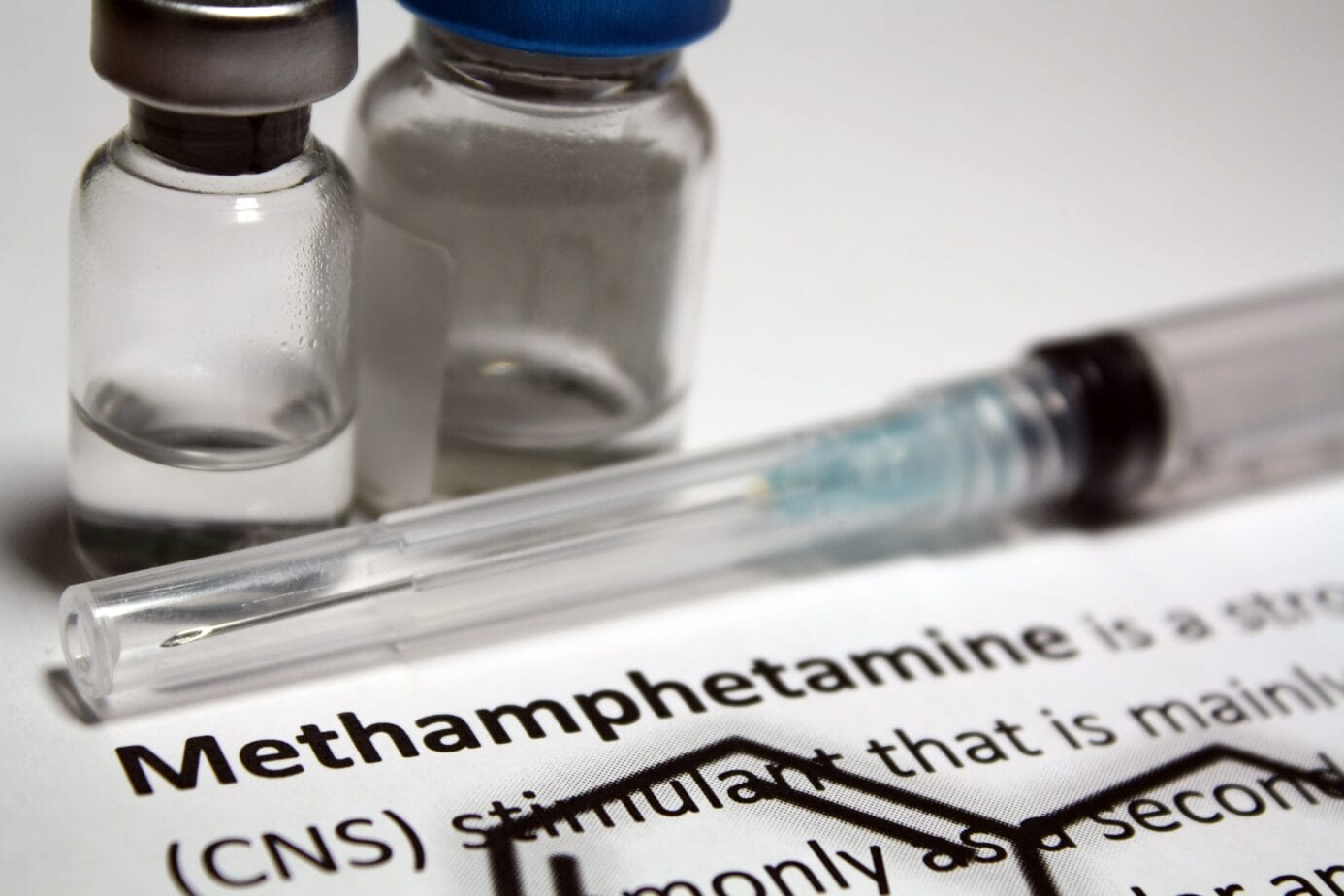
Methamphetamine, commonly known as meth, is a highly addictive and dangerous stimulant that can have devastating effects on both the mind and body. The powerful grip of meth addiction can lead to severe physical health problems, mental health issues, and destruction of personal relationships. At Keys Behavioral Health, we offer specialized treatment programs designed to help individuals overcome meth addiction and regain control of their lives. Our approach combines evidence-based practices, compassionate care, and personalized treatment plans to support lasting recovery.
Methamphetamine, commonly known as meth, is a powerful and highly addictive stimulant that affects the central nervous system. It comes in several forms, including powder, pill, and crystalline form—often called crystal meth. This drug is chemically similar to amphetamine, a substance used to treat ADHD and narcolepsy, but methamphetamine is far more potent and dangerous when misused.
Meth increases levels of dopamine in the brain, leading to intense feelings of euphoria, increased energy, alertness, and a sense of invincibility. However, these effects come at a steep price. The high is short-lived, which leads many users to take repeated doses in a short period—often referred to as "binge and crash" cycles. Over time, meth use leads to serious health issues, including severe dental problems ("meth mouth"), extreme weight loss, skin sores, and irreversible brain damage. It also drastically alters mood and behavior, often causing aggression, paranoia, and hallucinations.
Because of its high potential for abuse and limited medical use, methamphetamine is classified as a Schedule II controlled substance in the U.S. While certain forms are legally prescribed for specific conditions, the illegal production and recreational use of meth—especially in its crystal form—are major contributors to addiction, overdose, and community health crises across the globe.

Methamphetamine addiction is one of the most devastating substance use disorders due to the drug’s powerful effects and high potential for abuse. Often used for its intense energy boost and euphoric high, meth quickly rewires the brain’s reward system, making it extremely difficult to stop once use begins. Addiction to meth not only destroys a person’s physical and mental health but also erodes their personal relationships, career, and sense of self. Understanding the full scope of meth’s dangers is essential for early intervention and recovery.
Methamphetamine use puts the body under immense stress and leads to serious, often irreversible physical damage. One of the most well-known effects is "meth mouth," a condition marked by severe tooth decay, gum disease, and tooth loss due to dry mouth, poor hygiene, and teeth grinding. Chronic use also causes extreme weight loss, skin sores, and a gaunt, aged appearance. Users often compulsively scratch or pick at their skin, resulting in open wounds and infections.
Beyond cosmetic and surface-level damage, meth severely affects internal systems. It increases heart rate, blood pressure, and body temperature, putting users at high risk for heart attacks, strokes, and organ failure. Prolonged use can also damage blood vessels in the brain, leading to memory loss and cognitive decline. Sleep deprivation, malnutrition, and dehydration are common in long-term users, further weakening the body and leaving it vulnerable to illness and physical collapse.
Methamphetamine profoundly alters brain chemistry, causing long-lasting psychological damage. In the short term, users may experience heightened alertness, confidence, and energy, but these effects quickly give way to agitation, irritability, and anxiety. As the drug wears off, users often crash hard—experiencing depression, fatigue, and intense cravings. These dramatic mood shifts can happen within hours and fuel compulsive, repeated use.
With continued use, meth can lead to severe mental health issues, including paranoia, delusions, hallucinations, and even full-blown psychosis. Long-term users often report feeling like they’re being watched or followed, or that insects are crawling under their skin (a sensation known as "formication"). Emotional instability becomes the norm, and users may become increasingly aggressive or violent. Cognitive functions such as memory, attention span, and decision-making decline sharply, making it difficult to function in daily life or seek help. In many cases, the psychological damage from meth addiction can persist for months or even years after quitting.
The social fallout from methamphetamine addiction is severe and far-reaching. As the addiction deepens, users often withdraw from family, friends, and community, prioritizing the drug over relationships and responsibilities. Trust is broken through repeated lies, manipulative behavior, or criminal activity. Loved ones may grow distant or cut ties altogether, leaving the user feeling isolated and unsupported. Children of meth users often experience neglect or trauma, and relationships frequently end in conflict, domestic violence, or abandonment.
Employment and financial stability are also major casualties of meth addiction. The erratic behavior and poor decision-making associated with meth use often lead to job loss, absenteeism, and difficulty maintaining consistent work. Financial problems can spiral quickly as users spend money on drugs or turn to theft and fraud to support their habit. Legal troubles are common—meth users often face arrest for possession, drug-related offenses, or violent acts committed under the influence. These consequences make recovery more difficult, as addiction becomes intertwined with housing instability, criminal records, and broken social ties.
Methamphetamine addiction often starts with noticeable changes in behavior and energy levels. One of the earliest signs is a sudden burst of hyperactivity or increased talkativeness, as meth stimulates the central nervous system. Individuals may sleep very little, go without food for long periods, and become obsessively focused on certain tasks or activities. As the addiction deepens, users might engage in repetitive or compulsive behaviors—like cleaning, organizing, or fidgeting—and display erratic mood swings or unpredictable emotional outbursts.
Physical signs of meth addiction become increasingly evident over time. Users often experience rapid weight loss, skin sores from excessive scratching or picking, and dental problems known as “meth mouth,” characterized by rotting or missing teeth and inflamed gums. Dilated pupils, excessive sweating, and twitching are common during use, while long periods without sleep can lead to visible exhaustion and a gaunt appearance. In severe cases, users may look significantly older than their actual age due to the physical toll meth takes on the body.
Psychological symptoms are also key indicators of methamphetamine addiction. These may include intense paranoia, anxiety, or delusions—such as believing they’re being watched or followed. Hallucinations, both auditory and visual, are common in long-term users. Individuals may also show signs of aggression, restlessness, or emotional detachment. Despite the negative consequences in their personal, social, and professional lives, those addicted to meth continue using the drug compulsively, often feeling trapped by powerful cravings and unable to stop without help.

Methamphetamine addiction is a serious and complex condition, but recovery is absolutely possible with the right combination of medical, psychological, and emotional support. Because meth impacts both the body and brain in powerful ways, successful treatment requires a comprehensive, long-term approach. The path to recovery includes detox, therapy, support systems, and life changes that help individuals rebuild their lives and stay substance-free.
Detox is the first and often most physically challenging step in meth addiction treatment. Unlike opioids or alcohol, meth withdrawal doesn't typically involve life-threatening symptoms, but it can cause extreme fatigue, depression, anxiety, and intense cravings. These symptoms can make quitting feel overwhelming. A medically supervised detox program provides a safe and supportive environment where healthcare professionals monitor and manage symptoms, ensuring patients are physically stable and emotionally supported during this critical stage.
The detox phase usually lasts from several days to a couple of weeks, depending on the severity of the addiction. During this time, rest, hydration, and nutritional support are crucial. Although detox doesn’t address the underlying psychological issues of addiction, it lays the groundwork for deeper therapeutic work by helping individuals clear their minds and prepare for recovery.
Currently, there are no FDA-approved medications specifically for treating methamphetamine addiction like there are for opioids or alcohol. However, some medications may be used off-label to help manage withdrawal symptoms or underlying mental health conditions. For example, antidepressants or anti-anxiety medications may be prescribed during early recovery to stabilize mood and support emotional balance.
Recent studies have also shown promising results using a combination of bupropion (Wellbutrin) and naltrexone, which may help reduce cravings and the pleasurable effects of meth. Though not widely used yet, this emerging treatment offers hope for improving long-term outcomes when paired with behavioral therapy. Still, the cornerstone of meth treatment remains psychotherapy and a strong support system.
Therapy is the backbone of meth addiction treatment. It helps individuals explore the emotional triggers and behavioral patterns that drive drug use while building healthy coping strategies. Cognitive-behavioral therapy (CBT) is one of the most effective approaches—it teaches individuals how to recognize harmful thoughts, manage cravings, and avoid relapse.
Contingency Management (CM) is another proven method for treating meth addiction. This approach uses positive reinforcement, such as vouchers or rewards, for drug-free urine tests and consistent participation in treatment. Motivational Interviewing (MI) is often used to strengthen a person’s internal drive to change, especially for those who feel stuck or hopeless. Family therapy, individual counseling, and group sessions also help rebuild trust, address trauma, and create a network of emotional support.
Connecting with others who understand the struggle of addiction can be incredibly powerful. Support groups like Crystal Meth Anonymous (CMA) or Narcotics Anonymous (NA) offer a non-judgmental space for sharing experiences, building accountability, and finding encouragement. Regular meetings help individuals stay focused on their recovery goals and feel less alone in their journey.
For those who prefer alternatives to the 12-step model, programs like SMART Recovery or LifeRing offer science-based support groups that emphasize self-empowerment and practical tools. Peer support, whether through formal groups or informal relationships, plays a vital role in reducing relapse risk and increasing confidence during recovery.
Recovery isn’t just about quitting meth—it’s about building a new, healthier life. Establishing daily routines helps restore balance and structure, which is often lost during addiction. Simple habits like waking up at the same time, eating regular meals, and getting adequate sleep can greatly improve mental clarity and emotional stability.
Regular exercise boosts mood and energy, while healthy nutrition helps repair the body and brain after the damage caused by meth use. Engaging in stress-reducing activities such as meditation, yoga, creative hobbies, or journaling can also provide healthy outlets for emotions. Identifying and avoiding triggers—like certain people, places, or situations—is essential for staying on track.
Methamphetamine addiction is a chronic condition, meaning ongoing care is key to long-term recovery. Relapse prevention involves developing a strong support network, practicing healthy coping skills, and recognizing early warning signs of relapse. Creating a personalized relapse prevention plan can help individuals stay focused, especially during times of stress or vulnerability.
Continued therapy, regular check-ins with support groups, and involvement in the recovery community help maintain accountability and motivation. Celebrating milestones—whether it’s 30 days clean or a year—can reinforce progress and build self-esteem. With time, effort, and the right tools, people recovering from meth addiction can reclaim their lives and create a future they’re proud of.

Here are just a handful of things you can expect to receive from our team:
If you or someone you love is struggling with addiction, don’t wait to get help. Contact us today for addiction treatment in Tewksbury, MA.